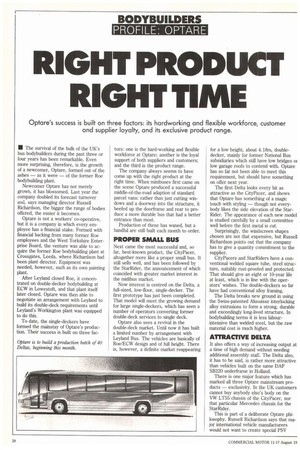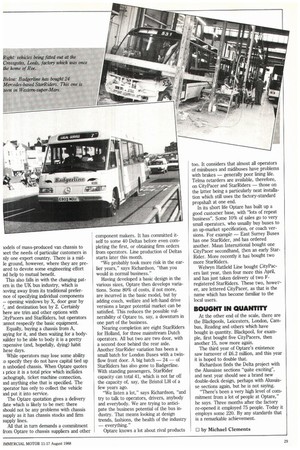RIGHT PRODUCT RIGHT TIME
Page 26

Page 27

If you've noticed an error in this article please click here to report it so we can fix it.
Optare's success is built on three factors: its hardworking and flexible workforce, customer and supplier loyalty, and its exclusive product range.
• The survival of the bulk of the UK's bus bodybuilders during the past three or four years has been remarkable. Even more surprising, therefore, is the growth of a newcomer, Optare, formed out of the ashes — as it were — of the former Roe bodybuilding plant.
Newcomer Optare has not merely grown, it has blossomed. Last year the company doubled its forecast turnover and, says managing director Russell Richardson, the bigger the range of bodies offered, the easier it becomes.
Optare is not a workers' co-operative, but it is a company in which every employee has a financial stake. Formed with financial backing from many former Roe employees and the West Yorkshire Enterprise Board, the venture was able to acquire the former Roe bodybuilding plant at Crossgates, Leeds, where Richardson had been plant director. Equipment was needed, however, such as its own painting plant.
After Leyland closed Roe, it concentrated on double-decker bodybuilding at ECW in Lowestoft, and that plant itself later closed. Optare was then able to negotiate an arrangement with Leyland to build its double-deck requirements until Leyland's Workington plant was equipped to do this.
To date, the single-deckers have formed the mainstay of Optare's production. Their success is built on three fac tors: one is the hard-working and flexible workforce at Optare; another is the loyal support of both suppliers and customers; and the third is the product range.
The company always seems to have come up with the right product at the right time. When minibuses first came on the scene Optare produced a successful middle-of-the-road adaption of standard parcel vans: rather than just cutting windows and a doorway into the structure, it beefed up the doorframe and rear to produce a more durable bus that had a better entrance than most.
Production of these has waned, but a handful are still built each month to order.
PROPER SMALL BUS
Next came the most successful and, so far, best-known product, the CityPacer, altogether more like a proper small bus. It still sells well, and has been followed by the StarRider, the announcement of which coincided with greater market interest in the midibus market.
Now interest is centred on the Delta, a full-sized, low-floor, single-decker. The first prototype has just been completed. That model will meet the growing demand for large single-deckers, which has seen a number of operators converting former double-deck services to single deck.
Optare also sees a revival in the double-deck market. Until now it has built a limited number by arrangement with Leyland Bus. The vehicles are basically of Roe/ECW design and of full height. There is, however, a definite market reappearing for a low height, about 4.18m, doubledecker, mainly for former National Bus subsidiaries which still have low bridges cm low garage roofs to contend with. Optare has so far not been able to meet this requirement, but should have something on offer next year.
The first Delta looks every bit as attractive as the CityPacer, and shows that Optare has something of a magic touch with styling — though not everybody likes the side elevation of the StarRider. The appearance of each new model is studied carefully by a small committee well before the first metal is cut.
Surprisingly, the windscreen shapes chosen are not that expensive, but Russell Richardson points out that the company has to give a quantity commitment to the supplier.
CityPacers and StarRiders have a conventional welded square tube, steel structure, suitably rust-proofed and protected. That should give an eight or 10-year life at least, which is in line with the operators' wishes. The double-deckers so far have had conventional alloy framing.
The Delta breaks new ground in using the Swiss-patented Alusuisse interlocking alloy extrusions to form a strong, durable and exceedingly long-lived structure. In bodybuilding terms it is less labourintensive than welded steel, but the raw material cost is much higher.
ATTRACTIVE DELTA
It also offers a way of increasing output at a time of high demand without needing additional assembly staff. The Delta also, it has to be said, is rather more attractive than vehicles built on the same DAF SB220 underframe in Holland.
There is one major feature which has marked all three Optare mainstream products — exclusivity. In the UK customers cannot buy anybody else's body on the VW LT55 chassis of the CityPacer, nor that particular Mercedes chassis for the StarRider.
This is part of a deliberate Optare philosophy. Russell Richardson says that major international vehicle manufacturers would not want to create special PSV iodels of mass-produced van chassis to ieet the needs of particular customers in nly one export country. There is a midle ground, however, where they are preared to devote some engineering effort nd help to mutual benefit.
This also falls in with the changing pateni in the UK bus industry, which is noving away from its traditional prefernice of specifying individual components — opening windows by X, door gear by r, and destination box by Z. Certainly here are trim and other options with :ityPacers and StarRiders, but operators :annot respecify the basic equipment.
Equally, buying a chassis from A, iaying for it, and then waiting for a bodymilder to be able to body it is a pretty :pensive (and, hopefully, dying) habit hese days.
While operators may lose some ability An specify they do not have capital tied up n unbodied chassis. When Optare quotes a price it is a total price which includes :achograph, ticket machine connection, and anything else that is specified. The nperator has only to collect the vehicle and put it into service.
The Optare quotation gives a delivery date which is likely to be met: there should not be any problems with chassis supply as it has chassis stocks and firm supply lines.
All that in turn demands a commitment from Optare to chassis suppliers and other component makers. It has committed itself to some 40 Deltas before even completing the first, or obtaining firm orders from operators. Line production of Deltas starts later this month.
"We probably took more risk in the earlier years," says Richardson, "than you would in normal business."
Having developed a basic design in the various sizes, Optare then develops variations. Some 80% of costs, if not more, are incurred in the basic model, but by adding coach, welfare and left-hand drive versions a larger potential market can be satisfied. This reduces the possible vulnerability of Optare to, say, a downturn in one part of the business.
Nearing completion are eight StarRiders for Holland, for three mainstream Dutch operators. All but two are two door, with a second door behind the rear axle. Another StarRider variation has been a small batch for London Buses with a twinflow front door. A big batch — 24 — of StarRiders has also gone to Badgerline. With standing passengers, StarRider capacity can total 41, which is not far off the capacity of, say, the Bristol LH of a few years ago.
"We listen a lot," says Richardson, "and try to talk to operators, drivers, anybody and everybody. We are trying to anticipate the business potential of the bus industry. That means looking at design trends, fashions, the health of the industry — everything."
Optare knows a lot about rival products too. It considers that almost all operators of minibuses and midibuses have problems with brakes — generally poor lining life. Telma retarders are available, therefore, on CityPacer and StarRiders — those on the latter being a particularly neat installation which still uses the factory-standard propshaft at one end. In its short life Optare has built up a good customer base, with "lots of repeat business". Some 10% of sales go to very small operators, who usually buy buses to an up-market specification, or coach versions. For example — East Surrey Buses has one StarRider, and has ordered another. Maun International bought one CityPacer secondhand, then an early StarRider. More recently it has bought two more StarRiders.
Welwyn Hatfield Line bought CityPacers last year, then four more this April, and has just taken delivery of two Fregistered StarRiders. These two, however, are lettered CityPacer, as that is the name which has become familiar to the local users.
BOUGHT IN QUANTITY
At the other end of the scale, there are the Blackpools, Leicesters, London, Cambus, Reading and others which have bought in quantity. Blackpool, for example, first bought five CityPacers, then another 15, now more again.
The third year of Optare's existence saw turnover of £6.2 million, and this year it is hoped to double that.
Richardson finds the Delta project with the Alusuisse sections "quite exciting", and next year should see a brand new double-deck design, perhaps with Alusuisse sections again, but he is not saying.
"There's been a very high level of commitment from a lot of people at Optare," he says. Three months after the factory re-opened it employed 75 people. Today it employs some 220. By any standards that is a remarkable achievement.












































